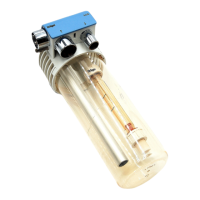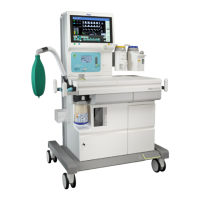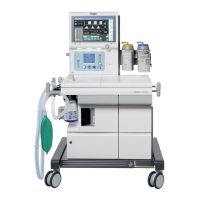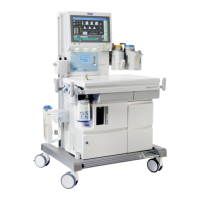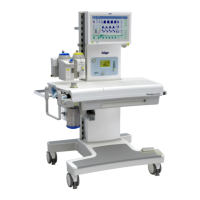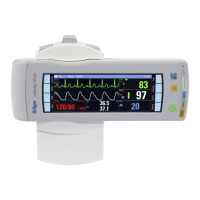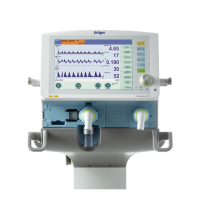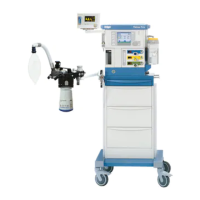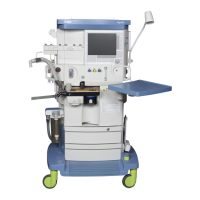
Do you have a question about the Dräger Apollo and is the answer not in the manual?
| Type | Anesthesia Workstation |
|---|---|
| Gas Supply | O2, N2O, Air |
| Integrated Monitoring | Yes |
| Ventilation Modes | Volume Control, Pressure Control, SIMV, Pressure Support, Manual |
| Vaporizer | Dräger Vapor 2000 |
| Patient Monitoring | ECG, SpO2, NIBP, Temperature |
| Power Supply | 100 – 240 VAC, 50/60 Hz |
| Tidal Volume Range | 20-1500 ml |
| Vaporizer Mounts | Up to 2 |
Defines the meaning of WARNING, CAUTION, and NOTE statements used in the document.
Provides general warnings and cautions applicable to the medical device's operation.
Details safety information specific to the Apollo anesthesia machine and its features.
Describes the intended purpose and application of the Apollo anesthesia machine.
Specifies the maximum safe weight limits for accessories mounted to the Apollo.
Lists abbreviations used in the software and on the device for clarity.
Identifies and labels the major physical components visible on the front of the Apollo machine.
Details the connections for gas supply cylinders and pipeline.
Explains the use and operation of optional anesthetic agent vaporizers.
Describes the function and operation of the Adjustable Pressure Limiting (APL) valve.
Explains the operation of the O2 flush valve for rapid oxygen delivery.
Details the organization of the screen into functional areas and elements.
Describes how to use the rotary knob, keys, and buttons for system interaction.
Explains the keys used to select ventilation modes and set parameters.
Details keys for monitoring functions and device configuration.
Explains the meaning of different colors used on the screen for status indication.
Outlines the necessary steps to prepare the Apollo for its initial use.
Provides instructions on charging the internal UPS battery for emergency power.
Details the procedure for correctly installing the breathing system and flow sensors.
Explains how to connect the compressed gas supplies (pipeline and cylinders).
Provides instructions for connecting backup gas cylinders to the anesthesia machine.
Describes how to connect the patient circuit and accessories for proper function.
Explains how to connect the anesthesia machine to the AC power supply.
Provides guidance on safely moving the anesthesia device within the clinic.
Guides the user through the manual and automated pre-use checkout procedures.
Details the automated self-test procedure for verifying system functionality.
Explains the system's leak tests for mechanical and Man/Spont modes.
Describes the procedure to quickly start the machine in emergency situations.
Summarizes the basic steps for starting and operating the Apollo anesthesia machine.
Explains how to load and configure default settings in Standby mode.
Details how to enter patient age, affecting calculations like MAC and alarm limits.
Guides the user on setting the desired fresh-gas flow levels using control knobs.
Provides instructions for setting anesthetic agent concentrations via vaporizers.
Describes the procedures for safely shutting down and preparing the Apollo.
Details the use of Manual/Spontaneous ventilation mode, including APL valve settings.
Explains the Volume-Controlled Ventilation mode and its parameters.
Describes the Pressure-Controlled Ventilation mode and its operational parameters.
Covers the Pressure Support Ventilation mode for patients with spontaneous breathing.
Explains the CPAP enhancement within the Pressure Support mode.
Provides guidance on transitioning between different ventilation modes.
Details the automatically displayed standard screen for monitoring.
Lists all parameters displayed on the Apollo, varying by screen and configuration.
Explains the SpO2 monitoring module, sensor selection, and connection.
Describes how to display graphical loops like Pressure/Volume and Flow/Volume.
Covers the measurement of O2, CO2, and anesthetic agents.
Defines MAC and explains its age-dependent calculation and influence.
Highlights critical safety precautions related to SpO2 sensor usage.
Explains alarm prioritization, color coding, and signal types.
Details how alarm messages are displayed and sorted by priority.
Provides instructions on how to silence audible alarms temporarily.
Shows how alarms are set ON or OFF based on the selected ventilation mode.
Guides the user on how to view and adjust alarm limits for various parameters.
Explains how to save and configure default settings invoked upon machine startup.
Covers configuration of system settings like alarm volume and breathing sound.
Details the selection and configuration of various operational parameters.
Explains how to select and configure default screen layouts.
Provides guidance on setting default and adjustable alarm limits.
Covers setting default parameters for ventilation modes and gas supply checks.
Describes how to select or change monitoring functions during ongoing operation.
Details configuration options for scaling, units, agent monitoring, and datalog entries.
Provides instructions for safely disassembling the Apollo anesthesia machine.
Outlines general principles for cleaning and disinfecting the machine components.
Specifies suitable disinfection methods and choice of disinfectants.
Lists components and their recommended processing methods for cleaning and sterilization.
Provides instructions for correctly reassembling the machine components after cleaning.
Details the procedure for filling and installing the soda lime absorber.
Describes required maintenance measures for ensuring proper device functioning.
Lists preventive maintenance intervals for various components.
Explains how to empty or replace the water trap to prevent contamination.
Addresses issues related to power failure and the use of the UPS.
Provides guidance for troubleshooting issues with gas supply failures.
Outlines steps to take if the ventilator unit fails.
Details troubleshooting steps for failures in the fresh-gas mixer.
An alphabetical list of Apollo alarms with their causes and recommended remedies.
Lists electrical and gas supply operating data and performance characteristics.
Details the EMC compliance and electromagnetic environment specifications.
Specifies the immunity levels and compliance for electromagnetic environments.
Outlines requirements for operating the device in combination with other equipment.
Explains how to connect the device to IT networks and associated risks.
Provides detailed specifications for fresh-gas flow delivery and measurement.
Lists specifications for the ventilator modes, settings, and performance.
Details the specifications for the sidestream gas measurement system.
Explains MAC definition, age-dependency, and xMAC display calculations.
Lists the standards and regulations the medical device complies with.
